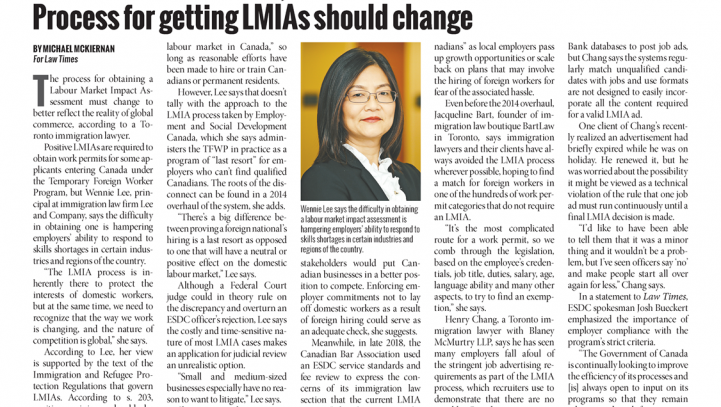Process for getting LMIAs should change – Law Times (Feb 4, 2019)
The process for obtaining a Labour Market Impact Assessment must change to better reflect the reality of global commerce, according to a Toronto immigration lawyer.
Positive LMIAs are required to obtain work permits for some applicants entering Canada under the Temporary Foreign Worker
Program, but Wennie Lee, principal at immigration law firm Lee and Company, says the difficulty in obtaining one is hampering
employers’ ability to respond to skills shortages in certain industries and regions of the country.
“The LMIA process is inherently there to protect the interests of domestic workers, but at the same time, we need to recognize that the way we work is changing, and the nature of competition is global,” she says.
According to Lee, her view is supported by the text of the Immigration and Refugee Protection Regulations that govern LMIAs. According to s.203, positive opinions should be issued if the employment of a foreign national “is likely to have a neutral or positive effect on the labour market in Canada,” so long as reasonable efforts have been made to hire or train Canadians or permanent residents.
However, Lee says that doesn’t tally with the approach to the LMIA process taken by Employment and Social Development Canada, which she says administers the TFWP in practice as a program of “last resort” for employers who can’t find qualified
Canadians. The roots of the disconnect can be found in a 2014 overhaul of the system, she adds.
“There’s a big difference between proving a foreign national’s hiring is a last resort as opposed to one that will have a neutral or
positive effect on the domestic labour market,” Lee says.
Although a Federal Court judge could in theory rule on the discrepancy and overturn an ESDC officer’s rejection, Lee says the costly and time-sensitive nature of most LMIA cases makes an application for judicial review an unrealistic option.
unrealistic option. “Small and medium-sized businesses especially have no reason to want to litigate,” Lee says. She says a simpler, more employer- driven process that incorporates the views of trade associations, unions and other stakeholders would put Canadian businesses in a better position to compete. Enforcing employer commitments not to lay off domestic workers as a result
of foreign hiring could serve as an adequate check, she suggests.
Meanwhile, in late 2018, the Canadian Bar Association used an ESDC service standards and fee review to express the concerns
of its immigration law section that the current LMIA process “often does not serve the interests of employers” and may actually be having “a negative impact on the employment of Canadians” as local employers pass up growth opportunities or scale back on plans that may involve the hiring of foreign workers for fear of the associated hassle.
Even before the 2014 overhaul, Jacqueline Bart, founder of immigration law boutique BartLaw in Toronto, says immigration lawyers and their clients have always avoided the LMIA process wherever possible, hoping to find a match for foreign workers in one of the hundreds of work permit categories that do not require an LMIA.
“It’s the most complicated route for a work permit, so we comb through the legislation, based on the employee’s credentials, job title, duties, salary, age, language ability and many other aspects, to try to find an exemption,” she says.
Henry Chang, a Toronto immigration lawyer with Blaney McMurtry LLP, says he has seen many employers fall afoul of the stringent job advertising requirements as part of the LMIA process, which recruiters use to demonstrate that there are no suitable Canadians or permanent residents to fill positions.
Employers must use the government-run Job Match or Job Bank databases to post job ads, but Chang says the systems regularly
match unqualified candidates with jobs and use formats are not designed to easily incorporate all the content required
for a valid LMIA ad.
One client of Chang’s recently realized an advertisement had briefly expired while he was on holiday. He renewed it, but he was worried about the possibility it might be viewed as a technical violation of the rule that one job ad must run continuously until a
final LMIA decision is made.
“I’d like to have been able to tell them that it was a minor thing and it wouldn’t be a problem, but I’ve seen officers say ‘no’ and make people start all over again for less,” Chang says.
In a statement to Law Times, ESDC spokesman Josh Bueckert emphasized the importance of employer compliance with the
program’s strict criteria. “The Government of Canada is continually looking to improve the efficiency of its processes and [is] always open to input on its programs so that they remain relevant and work for everyone, including employers, workers and the Canadian economy,” he added.
BY MICHAEL MCKIERNAN
For Law Times

